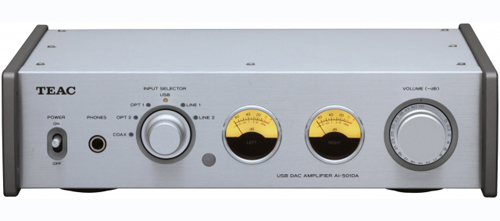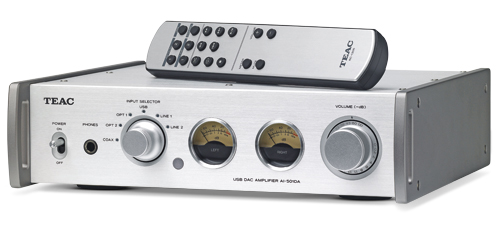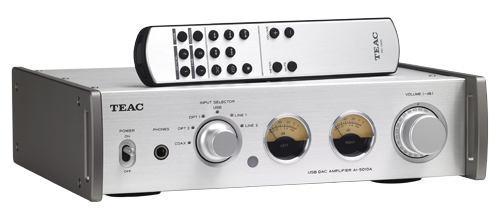What Hi-Fi? Verdict
The gorgeous retro design is hard to resist, but the TEAC fails to deliver an engaging and musical performance at this price
Pros
- +
Stunning retro design
- +
Impeccable build quality and compact size
- +
Nice, clean sound
- +
Decent detail and punch
- +
Supports high-res audio
Cons
- -
Isn’t as detailed, dynamic or exciting as rivals
- -
Can get confused with complex rhythms
Why you can trust What Hi-Fi?
We really like volume unit meters. Which is why we were immediately attracted to the retro styling of the TEAC AI-501DA.
An integrated stereo amplifier and DAC with high-resolution USB streaming, this device is compact and beautifully designed.
Design and build quality

The twin volume meters are the highlight of this stereo amplifier, with the amber backlight making things look even more striking.
The brushed metal chassis; the details around the input and volume controls; the weighty but smooth feel when using the controls, and the power switch that makes a satisfying ‘clunk’ sound when toggled – every aspect of the AI-501DA’s design feels lovingly crafted.
It’s a solidly built and sturdy cabinet, and the compact A4 size means it won’t take up much space on your hi-fi kit rack.
It also wouldn’t look out of place as part of a desktop system – it’s small enough, and either the silver or black finish will look good on any desk.
The TEAC amp is lovely to use as a whole. The controls are responsive and instinctive, and the supplied remote control is nicely made, too.
You can dim the meters’ backlight with the remote and easily switch between inputs.
Sound quality

We can’t help but want the TEAC amplifier to sound as good as it looks. And so we were sorely disappointed when the AI-501DA didn’t deliver the exciting, involving performance we were expecting.
It’s a clean sound that has good impact and a fine sense of timing, but it doesn’t have a great grasp of rhythm or fluid dynamics.
Play a 24-bit/44.1kHz file of Blue Bleezing Blind Drunk by The Unthanks via USB, and while it does a lovely job of delivering the clear, haunting vocals, it’s not the most involving or captivating performance.
It isn’t capable of reaching the dynamic lows and highs demanded by songs, and thus ends up sounding rather one-dimensional.
Switch to the line level input, and the TEAC’s slight hard edge softens just a touch.
The Rolling Stones’s Laugh, I Nearly Died has a nice, steady rhythm and it’s perfectly pleasant to listen to, but it needs more weight, more punch and more insight.
While the TEAC amp delivers a decent amount of detail, it’s only enough for casual, easy-going listening: it lays out all the elements of a song, but can’t quite dig deep enough to reveal the finer subtleties.
As a result, the benefits of playing high-resolution audio are reduced: the TEAC simply isn’t discerning enough to fully reveal the difference between a 24-bit/192kHz track and a CD-ripped song.
The amp does sound clean and punchy, though, but only when it has to deal with one single instrument or voice, such as the opening bars of Alicia Keys’ Fallin’.

As the rest of the instruments and more complex musical arrangements enter the picture, the TEAC gets slightly confused and sounds overwhelmed.
Its limitations are further laid bare when played against rival amplifier/DAC, the NAD D 3020.
Costing just £400, the NAD amp is ahead of the TEAC in terms of rhythm, detail and fluid dynamics – it’s such a musical, exciting and rhythmically interesting sound that the AI-501DA pales in comparison. And that’s quite a significant price difference, too.
The TEAC amp does sound wincingly bright and hard straight out of the box. We’d highly recommend at least two full days of running in before serious listening.
It calm downs a lot, but there’s still an edge to the sound, and we’d steer away from partnering the amp with bright-sounding speakers.
We tried a couple of speakers to find the right balance: our reference ATC SCM 11 speakers were far too transparent and the TEAC struggled to drive them.
The Monitor Audio BX2s gave a far more easy-going and rich sound, but we found it smoothed off the bite and attack of TEAC’s delivery just a bit too much for our liking.
We found a happy medium with the Q Acoustics Concept 20s – their smooth balance and forgiving nature paired up nicely with the AI-501DA.
Specifications

A class D amplifier and a 32-bit/192kHz BurrBrown DAC form the beating hearts of the AI-501DA, and it’s capable of streaming high-resolution audio files of up to 24-bit/192kHz via the USB and coaxial inputs.
There are two optical inputs on the back panel that support up to 24-bit/96kHz files. We found the optical connection to be more stable when used with a MacBook.
On the analogue side, there are two sets of line level RCA inputs, and a pair of speaker terminals. A 6.3mm headphone port is situated on the front panel.
The internal circuitry has also been carefully placed to ensure minimal heat and noise, thus negating the need for a cooling fan or heat sink.
Sure enough, the amp runs cool even after playing for a couple of hours.
Verdict
We have mixed feelings about the TEAC AI-501DA. On the one hand, we love the way it looks.
On the other, the sound quality just isn’t interesting enough to fully justify its £700 price. And when the NAD D 3020 performs better at nearly half the price, it’s hard to recommend the TEAC as the main driving force of your hi-fi system.
Sure, it’ll look good on your desk and you could use it as a decent, if exorbitantly expensive, headphone amplifier.
But as enticing as those volume meters look, the TEAC isn’t as tempting when it comes to sound quality.
See all our Best Buy amplifiers
What Hi-Fi?, founded in 1976, is the world's leading independent guide to buying and owning hi-fi and home entertainment products. Our comprehensive tests help you buy the very best for your money, with our advice sections giving you step-by-step information on how to get even more from your music and movies. Everything is tested by our dedicated team of in-house reviewers in our custom-built test rooms in London, Reading and Bath. Our coveted five-star rating and Awards are recognised all over the world as the ultimate seal of approval, so you can buy with absolute confidence.


